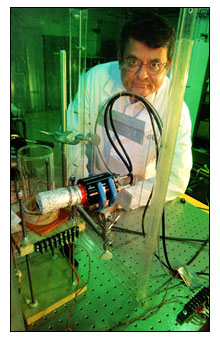WEST LAFAYETTE, Ind., March 9, 2006 -- In response to concerns raised in the scientific community, Purdue University said in a statement it is investigating the claims of one of its professors that he achieved "tabletop" fusion in collapsing bubbles.
According to the university, Rusi Taleyarkhan, a professor of nuclear engineering at Purdue since 2004, has published research findings in several journals showing evidence that "sonofusion" generates nuclear reactions by creating tiny bubbles that implode with tremendous force. Experimental nuclear fusion reactors have historically required large, multibillion-dollar machines, but sonofusion devices might be built for a fraction of that cost.

Rusi Taleyarkhan with his tabletop fusion equipment at the Oak Ridge National Laboratory, a US Department of Energy facility in Oak Ridge, Tenn., where he conducted research before joining Purdue University as a professor of nuclear engineering. Concerns raised in the scientific community have led to his research being investigated by the university. (US Department of Energy file photo/Lynn Freeny)
In addition to its potential as a new source of clean energy, Taleyarkhan and other researchers have said sonofusion could be used in a wide range of applications, from homeland security to the study of neutron stars and black holes, according to Purdue.
"Taleyarkhan first reported observing the bubble fusion effect in March 2002 in the journal Science," the Purdue statement said. "DARPA has continued to fund sonofusion research at Purdue and at other universities in an attempt to replicate or explain the initial findings and determine whether it is a potential new energy source."
Also in its statement, Purdue said that the journal Nature reported on its Web site Wednesday that some researchers have raised questions about the research Taleyarkhan has done at Purdue since 2004 and previously at ORNL, where he initially reported observing the bubble fusion effect.
Nature reports that, while scientists believe that sound waves can force collapsing bubbles to produce high levels of energy under certain conditions, Taleyarkhan's results have been questioned from the start. Researchers who first peer-reviewed the work criticized the publication of his initial paper because Taleyarkhan hadn't ruled out several sources for potential error, the journal said.
According to Nature, Brian Naranjo of the University of California, Los Angeles, has completed an analysis suggesting that the spectrum reported in Taleyarkhan's latest paper as proof of nuclear fusion came instead from the radioactive decay of standard lab material -- by a factor of more than 100 million. And the US Department of Energy has abandoned plans to patent the process after the patent office said it would throw it out last year.
Nature also reports that attempts to independently confirm Taleyarkhan's results have failed, and that faculty members, including Lefteri Tsoukalas and Tatjana Jevremovic, say that they now seriously doubt the reality of the bubble-fusion effect. They told the research journal that Taleyarkhan has declined to share the raw data he claims to have gathered in successful experiments, opposed the publication of his colleagues' negative results and, in May 2004, took the communal equipment they were using to replicate his work and put it in his off-campus lab.
Purdue Provost Sally Mason said in a statement that the university began a review last week after learning of the concerns. "There is disagreement within the scientific community, both here and elsewhere, concerning this research," Mason said. "I have asked Purdue's Office of the Vice President for Research to conduct a thorough review of the work and any concerns expressed about it. Purdue is well aware that there are legitimate differences of scientific opinion about the theories behind Dr. Taleyarkhan's work. Those differences are the reason scientists share their findings. The research claims are very significant, and the allegations are very serious. As in any scientific endeavor, Purdue's ultimate goals are truth and integrity."
Mason said the review process will be overseen by Peter Dunn, associate vice provost for research. For more information, visit: www.purdue.edu